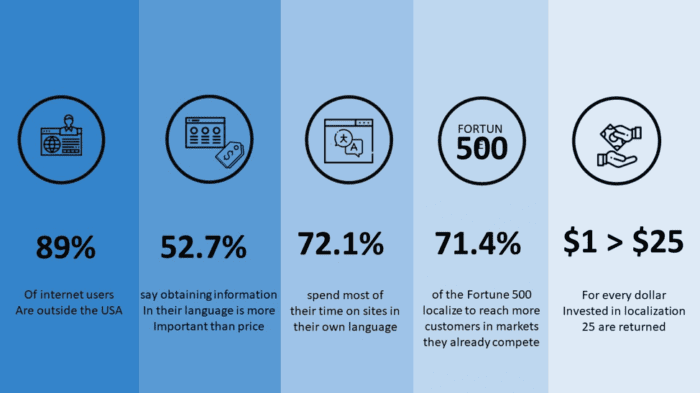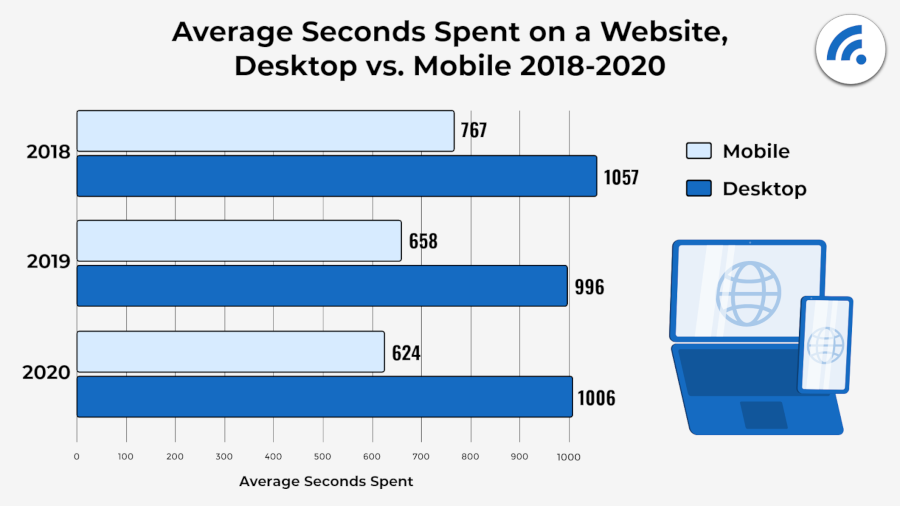We all have witnessed the rise of digitalization and how it has impacted businesses. Nowadays expanding your business and reaching clients from different parts of the world is not that difficult.
However, if your content localization game isn’t solid, it won’t let you connect with the customers on a personal level.
Summary
Successful and profitable content localization requires a strategy. In this article we overview the strategies you need to have a top performing foreign language website or app.
Table of Contents
What is content localization?
Effective steps to build a solid content localization strategy for your business

These statistics illustrate the importance of localization. Image source
The above statistics reflect how crucial it is to implement content localization. People want to be able to access your website in their native language. We may believe that English is a dominating language across the globe, but the data says otherwise. A whopping 75% of the world population doesn’t speak English.
So, to ensure a streamlined business process, you need to establish a content localization strategy.
Go to top
What is content localization?
Content localization is a process of making your product or services accessible to a specific location or market. You need to adapt your content and graphics as per your regional target audience.
GALA (the Globalization and Localization Association) has perfectly penned down the purpose of localization. “Localization is the process of adapting a product or content to a specific locale or market. The translation is only one of several elements of the localization process.”
Therefore, it’s essential not to confuse two terms; translation and localization. Content localization consists of various processes, and translation of the language is only one element of it.

It’s important to plan out localization strategy from the beginning of any international marketing project.
Effective steps to build a solid content localization strategy for your business
You’d be surprised to know that 75% of consumers prefer to only make purchases in their native language. Moreover, 86% of localization campaigns outperform English-only ad campaigns in CTR, conversions, and quality leads.
Therefore, you need to create a content localization strategy with a clear vision as to which market you want to tap into and the steps you need to take to achieve your goals.
1. Select and analyze your target market
The first step in creating a successful content localization strategy is to perform thorough research on the markets you want to tap into. If you’re not aware of which countries or cities to target, you can take a look at your website analytics.
Find out from which part of the world your website is generating the most traffic and start analyzing your target market. You can look into the consumer behavior and preferences, what type of local brand strategy is performing well, whether they prefer informal or formal content, etc.
For example if you find out that your product category is starting to grow in popularity in Latin America, you may want to localize your site from English to Spanish.
2. Pay heed to the technical aspect of localization
When you enter a new market, there will be time differences, currencies, punctuation rules, and differences in digital tools such as payment gateways and integrations.
The website layout and content placement need to be perfect if you want to offer an enhanced user experience. Therefore, when creating a website for a local market, you may need to make some alterations.
For example, you may not be able to use the layout of a UK website for a German website. Because when the language is translated to German, you may find the content spilling into the margins due to variations in length.

Websites and applications must be carefully designed so that they will still look good when translated into other languages.
3. Connect with local experts & translators
When it comes to translating the content, there’s no better resource available than the local person. You must reach out to local experts and translators to produce relevant content because professional translators are needed despite machine translators.
We all have witnessed the failures of big brands due to lack of localization and how the simple translation completely changed the meaning of their marketing campaign –
KFC’s campaign slogan ‘finger-lickin’ good’ translates to ‘eat your fingers off’ in Chinese.
So, the content needs to be relevant, not just translated.
The local expert of your target market knows more about the local marketing strategies and helps you localize your website content as per the consumer’s preferences.
Request Translations Now
Click the button below to tell us about your translation need and get a free quote.
Get a Free Quote
4. Localize your content
Once you’ve considered all the factors for content localization, you need to move ahead and complete the localization of the website content.
Add relevant slogans that match your brand and persuasive CTAs, and keep the website layout easy to access.
Coca-Cola even went as far as altering their brand name in China – “kekou kele”, which means ‘delicious happiness.’ Such little attention to detail has made China the third-largest market for Coca-Cola, selling more than 140 million sodas every day.
Apart from that, you also need to provide an option to your visitors to change the language so they can browse freely. Many websites have started using multilingual SEO techniques to attract global traffic.
Below is an example of FreshBooks – one of the most used accounting software and how they optimized their website for French. They have optimized their website for 6 countries like Australia, South Africa, France, Ireland, etc.


5. Keep an eye on the competition
In every market, there will be competitors; to gain an edge over them, you need to stay authentic and true to your vision.
Find out the gaps in your competitor’s marketing strategies and leverage them to build a better customer base for yourself. In fact, a good customer experience is all about how you treat them.
Therefore, focus on improving your customer support section, engaging with your prospects on multiple channels, and staying consistent.
Don’t compromise on your product/service as well as the overall customer support journey, and then only you’ll be able to strive in the market.
Hence, ensure that your team is well acquainted with the difference in language, culture, and tone of conversation when interacting with customers.

Competitor research is a key strategy for planning marketing and localization.
6. Optimize the content for mobile users
Your users won’t always be using the website. There are a lot of Millennials that now access everything from their mobiles or tablets.
Studies show that creating individual localized apps for each market can increase conversions by double or triple digits.
You need to check whether a task or purchase can be processed from mobile or not. Are your customers facing any challenges? Is the content/graphics clearly visible? Does the page load quickly or is it lagging?
Find out the issues and resolve them for optimal user experience.
In fact, if you glance at the data in the below image, the majority of users spend their time on their mobile, so your content needs to be optimized for mobile users as well.
7. Measure your progress
If you want to scale your business and create a brand presence in different parts of the world, it’s imperative to measure the progress periodically.
You can compare different strategies and content you produced in the past and find out which performed better. Doing so enables you to create better and successful content localization strategies in the future.
Like the Article?
Click here to share on Twitter>>
Tweet
Click here to follow IVANNOVATION on Twitter and be first to learn about our new content>> Follow @ivannovation
8. Increase efficiency with automation
Tackling all the tasks manually is not practical or effective. You need to implement automation into your process to ensure a streamlined flow and improved efficiency.
You must be handing data and information to different countries and regions, so you can use professional tools such as computer-assisted translation or bug tracking tools to automate and speed up parts of your process.

Old fashioned can be charming as a style, but an old fashioned translation workflow is inefficient and onerous. Automation makes translation management much easier.
Conclusion
A smart content localization strategy is the one that helps you connect your brand with your audience, so ensure that you follow the steps and create an unbeatable strategy!
The process will take time, so remain patient and approach every challenge with confidence, and soon, your company will be recognized across different countries.
About the Author
Narayani Pandya is an enthusiastic digital marketing professional, having work experience in sales and customer experience in the past. She enjoys having a cup of tea and walking on the grass when not working.




